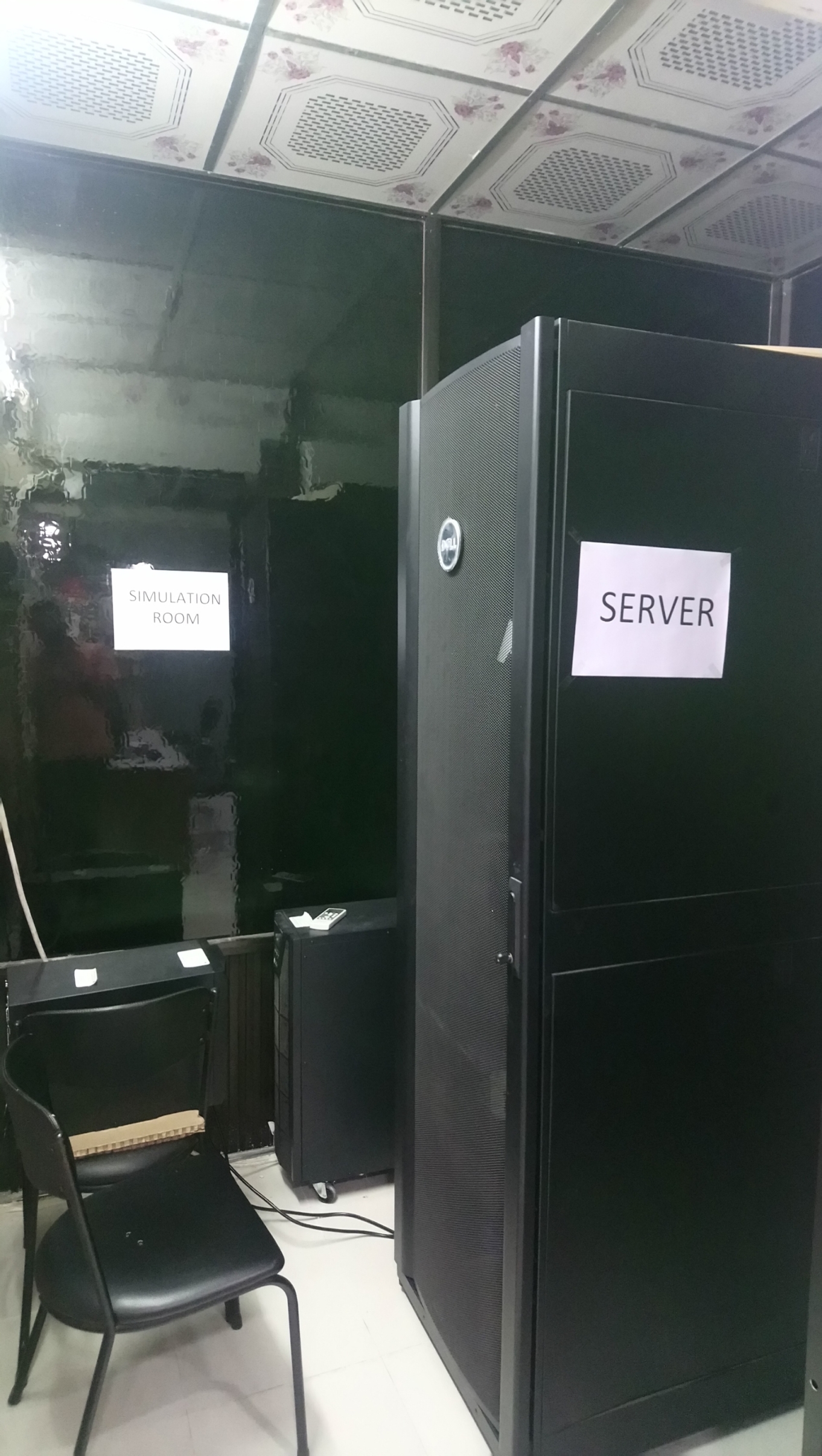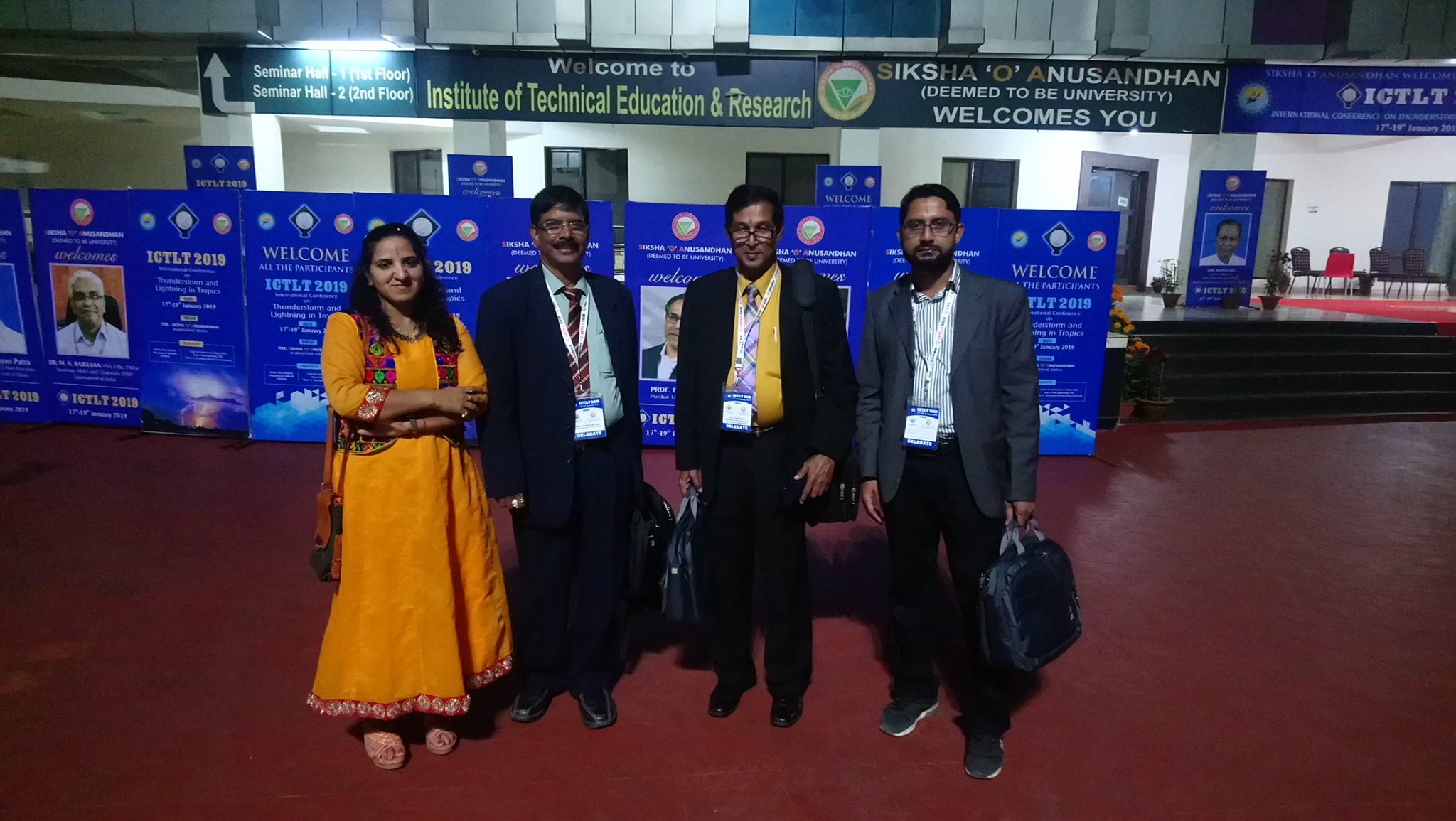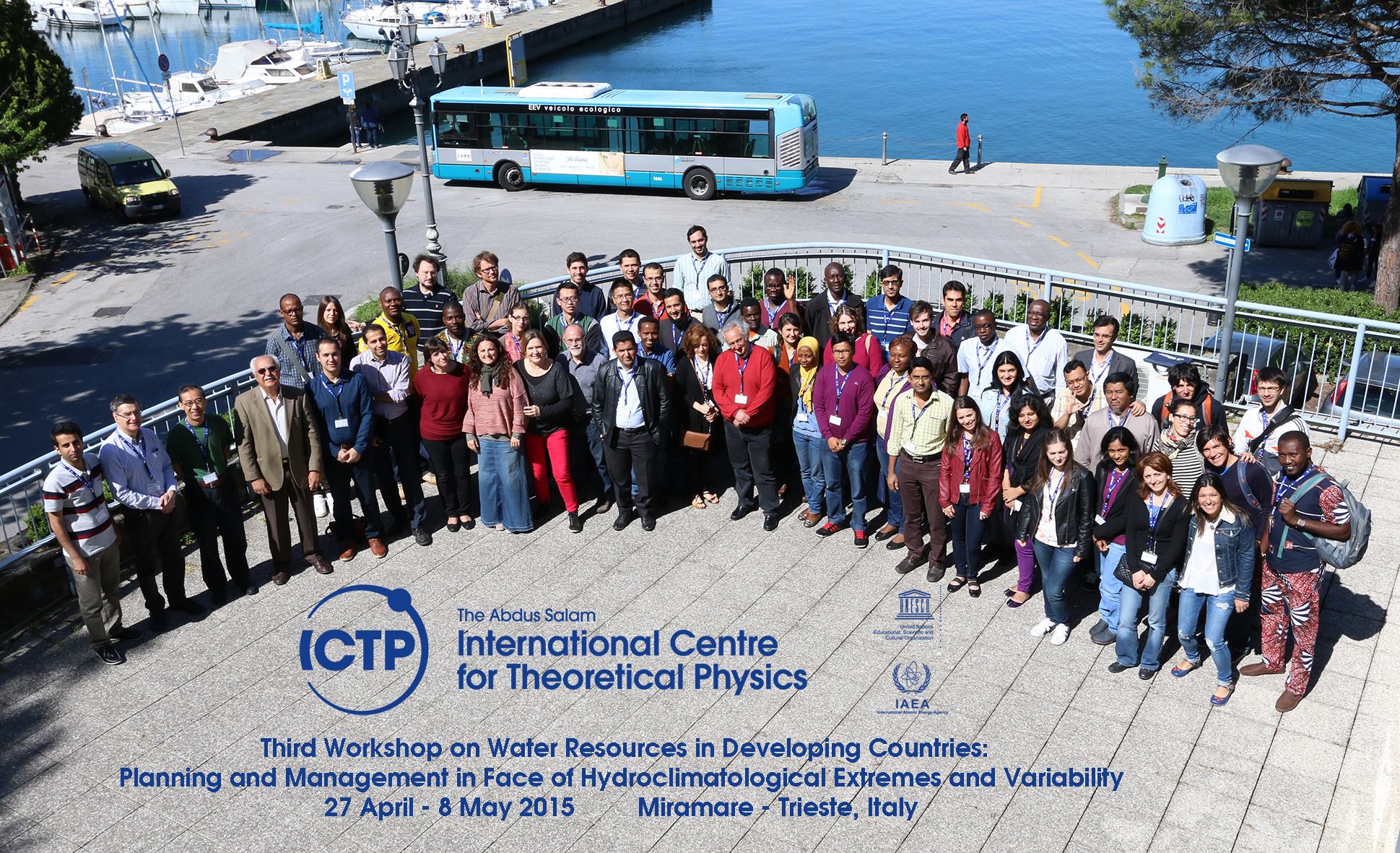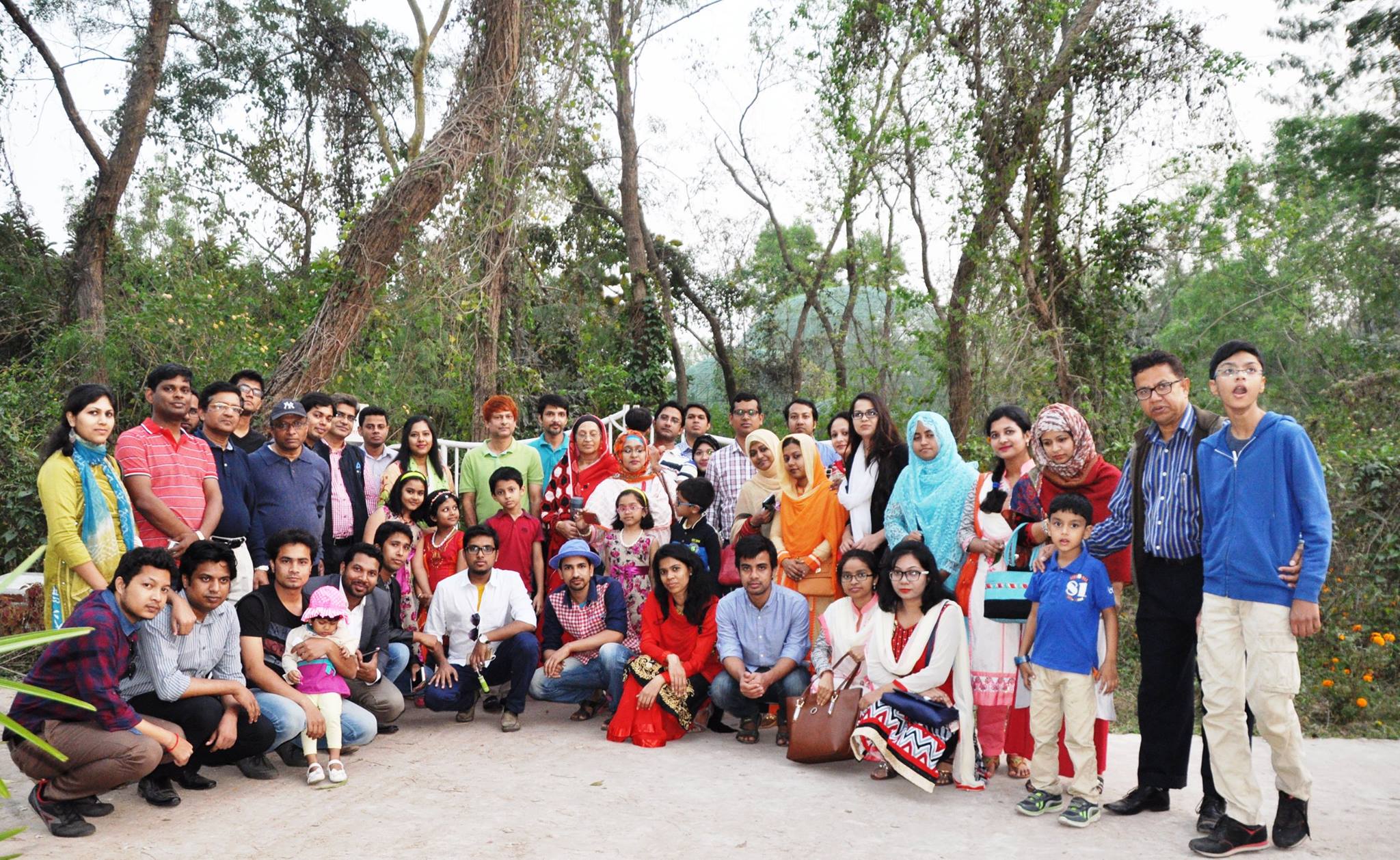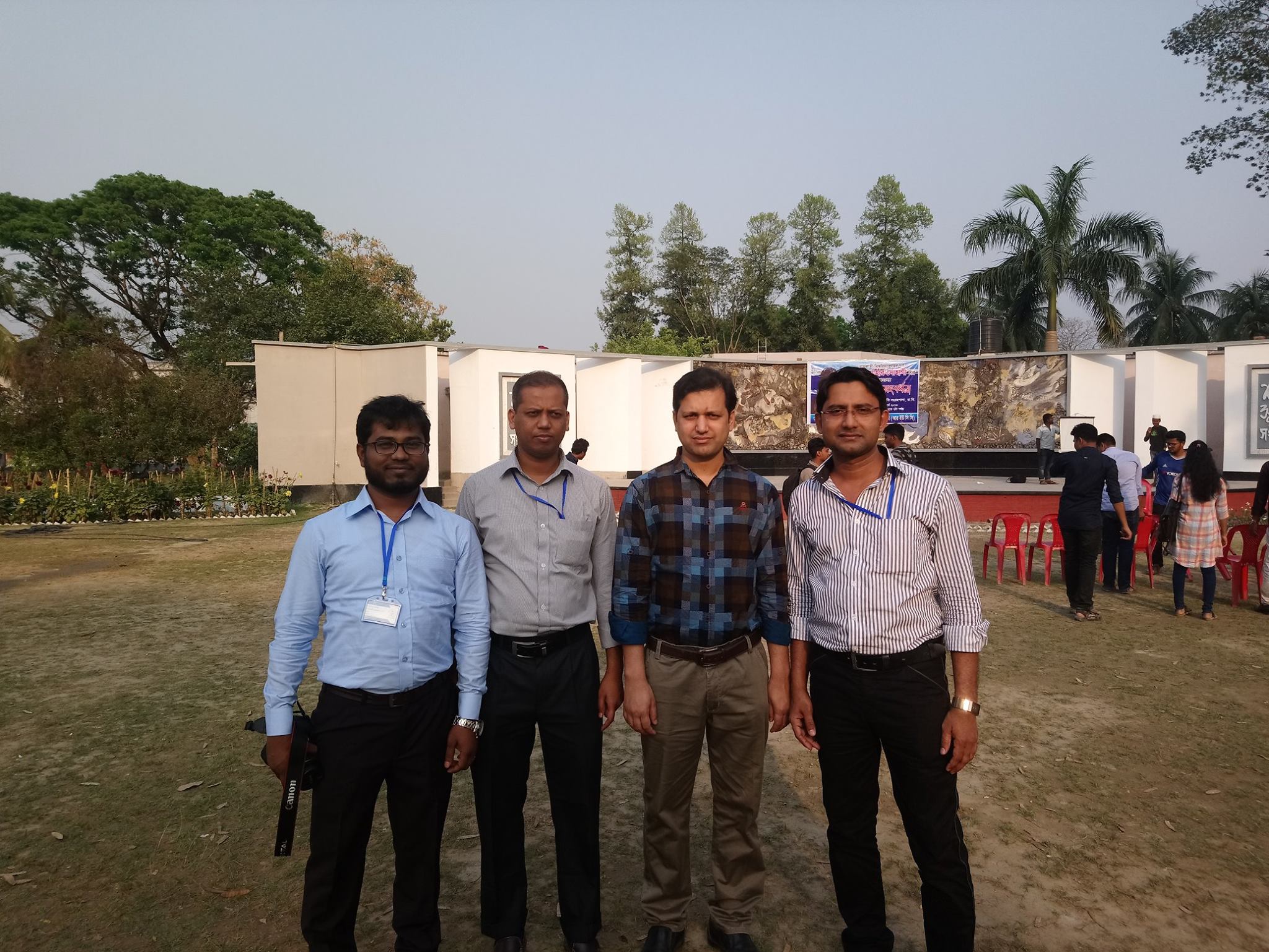

Bio
Mr. A. T. M. Shafiul Azam was born at Mymensingh, Bangladesh on August 31, 1982. He obtained B.Sc.(Honors) in 2005 (held in 2006) and M.Sc. in Physics in 2006 (held in 2008) securing First class in both the examination from the Department of Physics, Rajshahi University, Rajshahi, Bangladesh. He also completed M. Phil. in Physics from the Department of Physics, Bangladesh University of Engineering and Technology (BUET), Dhaka, Bangladesh. Mr. Shafi joined as a Lecturer in the Department of Physics, Bangladesh University of Engineering and Technology (BUET), Dhaka, on May 26, 2012 and promoted as Assistant Professor of Physics on July 30, 2016. Before joining BUET he worked as a Lecturer and Senior Lecturer in Physics at United International University (UIU), Dhaka from February 14, 2009 to March 14, 2010 and from March 15, 2010 to May 25, 2012, respectively. His research interest is in the field of Atmospheric Physics.
Education & Training
-
M. Phil 2015
Physics
Bangladesh University of Engineering and Technology (BUET)
-
M. Sc. 2006 (held in 2008)
Physics
Rajshahi University
-
B. Sc. 2005 (held in 2006)
Physics
Rajshahi University
Honors, Awards and Grants
Publications
Filter by type:
Sort by year:
Role of Pollutants on the Bimodal Lightning Distribution in Bangladesh
Journal Paper Earth Systems and Environment, 2025
Abstract
Abstract
The impact of atmospheric pollutants on lightning activity is an evolving issue. This study investigates the relationship between various pollutants and lightning occurrences in Bangladesh, a country that is frequently affected by extreme weather events. Using six years of cloud-to-ground lightning records (2015–2020) from Vaisala’s Global Lightning Dataset and pollutants data, including aerosols, particulate matter (PM1, PM2.5, and PM10), and other compounds from the ECMWF Atmospheric Composition Reanalysis 4, the study explores interactions between lightning and pollutions in detail. Over the study period, 754 lightning days and 1,438 non-lightning days were documented, with the highest stroke count of 817,547, observed on 5 April 2016. Lightning activity exhibited a bimodal distribution, with the primary peak in April-May and a secondary peak in August-September. The winter months (December-January) experienced the least lightning activity. The highest concentrations of DUST, SO4, and O3 coincided with the primary peak, revealing significant positive correlations (r = 0.7, 0.6, and 0.6, respectively) at the 99% confidence level. In contrast, PM1, PM2.5, and PM10 concentrations peaked in winter and showed moderately negative correlations (- 0.5) with lightning. A comparative analysis reveals that DUST and SO4 concentrations during the primary lightning peak were 88% and 51% higher than in the secondary peak. These findings suggest that the transportation of large amounts of DUST and SO4 by strong upper-level westerlies in April-May, and smaller amounts by low-level southwesterlies in August-September, significantly influences the observed bimodal distribution of lightning activity in Bangladesh, potentially through modifications in thundercloud dynamics.
Comparison of Diurnal Variation of Rainfall of GSMaP and Rain Gauge Data in Bangladesh
Abstract
ABSTRACT
The diurnal variation of rainfall across Bangladesh is evaluated using data from the Global Satellite Mapping of Precipitation (GSMaP). GSMaP data has a temporal resolution of 1 hour and a spatial precision of 0.1 degree. GSMaP data is combined with three hourly rain gauge data from 35 sites of Bangladesh Meteorological Department (BMD). The diurnal variation of rainfall and their spatial distribution are compared in daily, monthly and yearly scales during the period of 2001-2015. It is observed that GSMaP data is well correlated with BMD rain gauge data. The correlation coefficients between GSMaP and BMD rain gauge for 3-hourly, daily, monthly and yearly rainfall are found 0.71, 0.74, 0.82 and 0.66, respectively. The GSMaP measured daily maximum rainfall over Bangladesh at 0300 LST (Local Standard Time) with a secondary maximum peak at 1500 LST, whereas, rain gauge got primary peak at 0600 LST with a secondary peak at 1500 LST. The diurnal variation of rainfall observed by GSMaP is well matched with rain gauge observation during the pre-monsoon, postmonsoon and winter season. During monsoon season, the primary peak of rainfall is measured at 1500 LST by GSMaP whereas rain gauge is found at 0600 LST. The maximum rainfall is found in the southern, western, eastern and central regions of the country during 1200-1500 LST. In the southeastern region of Bangladesh the maximum rainfall is found during 0600-0900 LST. The maximum rainfall is observed in the northwestern and northeastern regions of the country during 0300-0600 LST.
Study of a Heavy Rainfall Event in Bangladesh Using Global Satellite Mapping of Precipitation Data
Abstract
Flood or flash flood monitoring and forecasting is a complicated tasks in densely inhabited and low -lying topography areas like Bangladesh. Recently, flash flood showed its hazardous and devastating affect in the northeastern part of the country especially Sumamganj, Kishoreganj, Netrokona due to heavy rainfall in those area and upper catchment area in India. Due to lack of rainfall data of upper catchment area in India, flash flood forecasting was not possible. Global Satellite Mapping of Precipitation (GSMaP) data can be used for flash flood forecasting. GSMaP is a high spatiotemporal resolution (0.1°×0.1°; 1 hourly) data and available four hour later after the observation. To validate GSMaP data, 3-hourly data of 35 rain gauge stations of Bangladesh Meteorological Department (BMD) used for the study period 2001-2015. Different threshold rainfall events are also studied. Several statistical analyses showed that GSMaP data are well correlated with rain gauge data. The correlation coefficients between GSMaP and BMD rain gauge for 3-hourly,and daily are found 0.71and 0.74 respectively. The Standard Deviation (SD) of 3 -hourly rainfall for G SMaP and rain gauge data are found 1.96 and 2.10 mm, respectively. According to BMD, there are five types of threshold rainfall events such as Very Heavy Rainfall (VHR > 88 mm in 24 hour), Heavy Rainfall (88 ≥ HR ≥ 43.5 mm in 24 hour), Moderate Heavy Rainfall (43.5 > MHR ≥ 22.5 mm in 24 hour), Moderate rainfall (22.5 > MR ≥ 10.5 mm in 24 hour) and Light rainfall (10.5 > LR ≥ 2.5 mm in 24 hour). The average yearly occurrence of VHR, HR, MHR, MR and LR events are found 4.1, 11.7, 17.9, 23.5 and 35.4 for BMD rain gauge data and 2.30, 8.03, 14.13, 22.56, and 42.58 for GSMaP data, respectively. The performance of GSMaP data to detect the events is 97%. So GSMaP data may be used to predict the flash flood, especially in areas where rain gauge data are limited.
Analysis of lightning activity and its relation with pollutants over Bangladesh
Abstract
Lightning is a natural disaster that frequently occurs in Bangladesh and causes many casualties and economic losses. In recent years, Bangladesh has been experiencing an increased number of lightning casualties, causing a significant threat to human civilization. The monthly, seasonal, and annual distribution of lightning flash (LF) using the World Wide Lightning Location Network (WWLLN) data from 2010 to 2020 are analyzed, and also examined the effect of particulate matter (PM10), aerosol optical depth (AOD), dust aerosol optical depth (DUAOD), sulphate aerosol optical depth (SUAOD), nitrogen dioxide (NO2), ozone (O3), collected from the European Centre for Medium-Range Weather Forecasts (ECMWF) data. To calculate lightning flash from WWLLN data, the study area has been divided with a grid of 0.75° longitude × 0.75° latitude because the ECMWF dataset has the same resolution. The PM10 and AOD showed a positive linear relation with the LF in the annual scale. The correlation coefficient (r) for the monthly, seasonal and annual variation of LF with DUAOD (SUAOD) are found 0.70(0.59), 0.96(0.80), and 0.68(0.67), respectively. The values of r for the monthly, seasonal, and annual variation of LF with NO2 (O3) are 0.78(0.83), 0.93(0.92), and 0.86(0.82), respectively. The spatial distribution of LF correlates well with the variations of NO2 and O3. It may be concluded that the increased pollution within the vicinity of the storm environment is related to increased lightning flash rate, leading to an increase in nitrogen dioxide and, therefore, an increase in ozone concentration.
Keywords: Lightning, Aerosol, Nitrogen oxide, Ozone
Spatial and vertical distributions of hydrometeors of severe thunderstorms in Bangladesh
Abstract
Objectives: To simulate severe thunderstorms using the weather research and forecasting (WRF) model for analyzing the spatial and vertical distributions of hydrometeors.
Methods: 81 people were died due to thunderstorms occurred in Bangladesh on 12 and 13 May 2016 which have been selected for simulation using the WRF model with a domain having the horizontal grid spacing of 3 km ´ 3 km. The WRF Single-Moment (WSM) 6-class cloud microphysics scheme and Yonsei University (YSU) PBL scheme were selected for the present study. The lightning parameterization scheme of PR92 based on 20 dBZ top was selected for the lightning option. The 6-hourly NCEP-GDAS data was used as the atmospheric initial and boundary conditions. The model output was attained at every 15-minutes interval. The simulation results were verified with Bangladesh meteorological department’s observation. The simulated hydrometeors are analyzed and examined for understanding their spatial and vertical distributions in addition their relationship with lightning flashes.
Results: The vertical structure of the convective system for both the cases shows that the intense core region with reflectivity ~55 dBZ reaches up to 500 mb, suggesting strong convection. Strong updrafts are found between the temperature ranges from -5 to -30°C. The strong downdrafts are found below the core of maximum reflectivity at 0°C level, which may assist for enormous charge separation inside the convective systems. The vertically integrated hydrometeors show homogeneous spatial variation as lightning flash and maximum reflectivity for both the cases. The graupel, snow and ice particles are found at a higher atmospheric level from around 600 to 200 mb. Intense liquid water dominant in the lower atmospheric level at around 800 mb. The simulation of thunderstorms indicates the coexistence of supercooled water droplets, graupel and ice particles in the higher atmosphere above 0°C.
Conclusions: The spatial and vertical distributions of hydrometeors showed the coexistence of supercooled water, graupel and ice particles in the mid-level (600 mb) to the higher-level (200 mb) suggesting the possibility of a strong riming process which the key factors for the intense lightning activity.
Keywords: Thunderstorm, lightning, WRF simulation, hydrometeors, Bangladesh.
Study on Characteristics of Lightning Flash and Associated Hydrometeors
Abstract
Abstract Two severe thunderstorms that occurred in Bangladesh on 12 May 2016 and 13 May 2016 and killed 81 people have been selected for simulation using Weather Research and Forecasting (WRF) model. The simulation was performed with the two nested domains with horizontal grid resolutions of 3 km for the outer and 1 km for the inner domain. The 6 hourly data of 0.25° × 0.25° resolution collected from the NCEP GDAS are used for the model initial and boundary conditions. The WRF Single-Moment (WSM) 6-class cloud microphysics scheme and Yonsei University (YSU) PBL scheme were selected for the present study. The lightning parameterization scheme of PR92 based on 20 dBZ top was selected for the lightning option. The simulation results are verified with TRMM 3B42 and Kalpana satellite data. The simulated parameters such as reflectivity, cloud water mixing ratio, ice mixing ratio, snow mixing ratio, graupel mixing ratio, etc. are analyzed and examined for understanding the relation between lightning flashes and different hydrometeors. For both cases, the vertical structure of the convective systems shows that the intense core region with reflectivity ~50 dBZ reaches up to 350 mb, indicating strong convection. The strong downdrafts are found below the core of maximum reflectivity at 0°C level. Strong updrafts are observed between the temperature ranges from -10 to -30°C, which may help for intense charge separation within the convective systems. The vertically integrated hydrometeors show similar spatial distributions of maximum reflectivity and lightning flash for both cases. The graupel, snow and ice particles are found to be retained at a higher atmospheric level from around 600 to 200 mb. Maximum liquid water exists in the lower atmospheric level at around 800 mb. The simulation of thunderstorms suggests the coexistence of ice particles and supercooled water in the higher atmosphere above 0°C. The existence of supercooled water and graupel in the mid-level (600 mb) to the higher-level (200 mb) indicating the possibility of a strong riming process are the key factors for the lightning activity. This study reveals that the WRF model may be used for forecasting thunderstorms and lightning activity in Bangladesh.
Keywords thunderstorm, lightning, WRF simulation, hydrometeors
Influence of meteorological parameters on lightning flash in Bangladesh
Abstract
The monthly distribution of lightning flash count (FC) using Tropical Rainfall Measuring Mission LIS lightning data from 2003 to 2012 are analyzed over Bangladesh and also examined the effect of meteorological parameters such as surface maximum temperature, boundary layer height (BLH), high cloud cover (HCC), mean sea level pressure (MSLP) and relative humidity (RH) on FC. It is found that the monthly variation of lightning activity over Bangladesh is strongly correlated with temperature and with BLH. The correlation coefficients (r) of monthly variation of FC with temperature and BLH are 0.70 and 0.83, respectively. The yearly variation of FC also shows strong correlation with HCC and MSLP, whereas it is moderately correlated with RH. The values of r for yearly variation of FC with HCC, with MSLP and with RH are 0.8, 0.64 and 0.55, respectively. Based on the analysis we expect that the above meteorological parameters influences to the lightning activity over Bangladesh.
Effect of aerosol on lightning flash over Bangladesh
Abstract
Lightning is a natural phenomenon that occurs during a thunderstorm by an electrical discharge between two electrically charged regions in a cloud, between two clouds or between a cloud and earth surface. Now-a-days Bangladesh experiences more lightning activities than the usual frequency which is a threat to human life. After 81 peoples death on 12 and 13 May, 2016, Bangladesh government announced lightning as a natural disaster. Ten years data of sea salt aerosol (SSA), dust aerosol (DUA), organic matter aerosol (OMA), black carbon aerosol (BCA), sulphate aerosol (SUA) and other atmospheric parameters from the European Centre for Medium-Range Weather Forecasts (ECMWF) and monthly distribution of lightning flash (LF) of Tropical Rainfall Measuring Mission (TRMM) LIS lightning data from 2003 to 2012 are analyzed to find out the effect of aerosols on LF. Among various atmospheric parameters, the monthly LF is strongly correlated with total column nitrogen oxides (TCNOX) and boundary layer height (BLH). The correlation coefficients (CC) of monthly LF with TCNOX and BLH are found 0.70 and 0.83, respectively which are highly significant. The yearly variation of LF is highly correlated with TCNOX, mean sea level pressure (MSL), and high cloud cover (HCC). The CC of yearly variation of LF with TCNOX, MSL, and HCC is found 0.50, 0.64, and 0.80, respectively. The CC between monthly LF and SSA, DUA, OMA, BCA, and SUA are 0.03, 0.71, 0.24, 0.03, and 0.71, respectively. It is revealed that the monthly LF is strongly affected by DUA and SUA in Bangladesh.
Relation between lightning flash and atmospheric aerosol over Bangladesh
Abstract
Lightning is a sudden electrostatic discharge that occurs typically during a thunderstorm. This discharge occurs between electrically charged regions of a cloud, between two clouds or between a cloud and the ground. Now-a-days Bangladesh experiences more lightning activities than the usual frequency which is threat to the human life. Bangladesh government declared lightning as a natural disaster by following the deaths of 81 people on 12 and 13 May, 2016. The monthly distribution of lightning flash (LF) using Tropical Rainfall Measuring Mission (TRMM) LIS lightning data from 2003 to 2012 are analyzed and also examined the effect of aerosols i.e. sea salt aerosol (SSA), dust aerosol (DUA), organic matter aerosol (OMA), black carbon aerosol (BCA), sulphate aerosol (SUA) and other atmospheric parameters on LF over Bangladesh. In this study aerosol optical depth at 550 nm are used for aerosol data from The European Centre for Medium-Range Weather Forecasts (ECMWF). The correlation coefficients (CC) between monthly LF and SSA, DUA, OMA, BCA, and SUA are 0.03, 0.71, 0.24, 0.03 and 0.71, respectively. It is revealed that the monthly LF is strongly affected by DUA and SUA in Bangladesh. The CC between monthly LF and total aerosol is found 0.70. Among various atmospheric parameters, the monthly LF is strongly correlated with convective available potential energy (CAPE), total column nitrogen oxides (TCNOX) and boundary layer height (BLH). The CC of monthly LF with CAPE, TCNOX and BLH are found 0.92, 0.70 and 0.83, respectively which are highly significant.
Comparison of Diurnal Variation of Rainfall of GSMaP and Rain Gauge Data in Bangladesh
Abstract
Global Satellite Mapping of Precipitation (GSMaP) data are used to evaluate the diurnal variation of rainfall over Bangladesh. The temporal and spatial resolution of GSMaP data are 1 hour and 0.1 degree by 0.1 degree, respectively. GSMaP data are also compared with three hourly rain gauge data of 35 stations of Bangladesh Meteorological Department (BMD). The diurnal variation of rainfall and their spatial distribution are observed in daily, monthly and yearly scales during the period of 2001-2015. It is observed that GSMaP data is well correlated with BMD rain gauge data. The correlation coefficients between GSMaP and BMD rain gauge for 3-hourly, daily, monthly and yearly rainfall are found 0.71, 0.74, 0.82 and 0.66, respectively. The GSMaP measured daily maximum rainfall over Bangladesh at 0300 LST (Local Standard Time) with a secondary maximum peak at 1500 LST, whereas, rain gauge observed primary peak at 0600 LST with a secondary peak at 1500 LST. The diurnal variation of rainfall observed by GSMaP is well matched with rain gauge observation during the pre-monsoon, post-monsoon and winter season. During monsoon season, the primary peak of rainfall is measured at 1500 LST by GSMaP whereas rain gauge is found at 0600 LST. The maximum rainfall is found in the southern, western, eastern and central regions of the country during 1200-1500 LST. In the southeastern region of Bangladesh the maximum rainfall is found during 0600-0900 LST. The maximum rainfall is observed in the northwestern and northeastern regions of the country during 0300-0600 LST.
Validation of Integrated Multi-Satellite Retrievals for GPM Data in Bangladesh
Abstract
To study the possibility to use of Integrated Multi-satellitE Retrievals for GPM (IMERG) rainfall data in Bangladesh, half-hourly IMERG data of spatial resolution 0.1degree×0.1degree and three hourly Bangladesh Meteorological Department (BMD) rain gauge data of 35 stations are used. The study period was from April, 2014 to May, 2015. In daily scale, the Correlation Coefficient (CC) and Root Mean Square Error (RMSE) between IMERG and rain gauge data is found 0.79 and 6.19, respectively. The IMERG and BMD observed daily average rainfall is found 4.18mm and 5.61mm during the study period, respectively. IMERG is able to measure 74.5% of the surface rainfall in Bangladesh during the study period. In monthly and seasonal scale, the IMERG data is highly correlated with BMD observation. The IMERG rainfall is overestimated by 7.93% (29.35mm) and 12.09% (3.36mm) during the pre-monsoon and winter seasons, respectively. On the other hand, IMERG rainfall is underestimated by 37.58% (629.33mm) and 3.54% (2.65mm) during the monsoon and post-monsoon seasons, respectively. The yearly underestimation of IMERG data was 27.9%. IMERG and BMD data detect 45.40 and 40.74 light rainfall (≥2.5 to <10.5mm) events, and 1.54 and 3.51 very heavy rainfall (>88mm) events during the study period, respectively. IMERG is able to detect light rainfall more precisely than the very heavy rainfall. IMERG and BMD data detect 319 and 311 extreme low (10th percentile) rainfall events, and 8 and 12 extreme high (90th percentile) rainfall events during the study period, respectively. Further studies are necessary to explore the potential of GPM-era IMERG data for meteorological, and hydrological research in Bangladesh.
Comparison of Integrated Multi-Satellite Retrievals for GPM (IMERG) Monthly Precipitation and Rain Gauge Data
Abstract
Study of Diurnal Variation of Rainfall in Bangladesh Using GSMaP Data
Abstract
To study the diurnal variation of rainfall and possibility to use of Global Satellite Mapping of Precipitation (GSMaP) data in Bangladesh, GSMaP hourly data of spatial resolution of 0.1 degree by 0.1 degree and three hourly rain gauge data of 35 stations of Bangladesh Meteorological Department (BMD) are used. Daily, monthly, seasonal and yearly diurnal variation of rainfall and their spatial distribution are studied during the period 2001-2015. It is found that GSMaP data is highly correlated with rain gauge data. The correlation coefficients between GSMaP and BMD rain gauge for daily, monthly and yearly rainfall are found 0.90, 0.96 and 0.66, respectively. From this study, it is found that GSMaP measured daily maximum rainfall over Bangladesh at 0300 LT (Local Time) with a secondary maximum peak at 1500 LT whereas rain gauge observed primary peak at 0600 LT with a secondary peak at 1500 LT. The seasonal primary peak of GSMaP is well matched with rain gauge observation during winter, pre-monsoon and post-monsoon. Whereas the primary peaks of GSMaP and rain gauge are found at 1500 and 0600 LT during monsoon season. The seasonal secondary peaks observed by GSMaP are not well match with observation except winter season. Daily maximum rainfall of southern, western, eastern and central regions of the country is occurred during 1200-1500 LT on the other hand southeastern regions of Bangladesh is found during 0600-0900 LT. In the northwestern and northeastern regions of the country the maximum rainfall is found during 0300-0600 LT.
Study of Rainfall in Bangladesh Using Global Precipitation Measurement Data
Abstract
Bangladesh is recognized worldwide as one of the most vulnerable countries to the impacts of strong rainfall variability. Rainfall is among the atmospheric parameters, one of the most difficult to measure because of its high temporal and spatial variability and discontinuity. To study the possibility of use of Global Precipitation Measurement (GPM) data in Bangladesh, half hourly rainfall data of Integrated MultisatelliE Retrievals for GPM (IMERG) and three hourly Bangladesh Meteorological Department (BMD) rain gauge data are used. The daily, monthly and seasonal variations of rainfall are studied during April, 2014 to May, 2015. The correlation coefficients between daily and monthly rainfall are found 0.86 and 0.99. The root mean square error is found 5.05 between IMERG and rain gauge data. The IMERG and BMD observed daily average rainfall is found 4.29 mm and 5.54 mm, respectively. It is found that yearly rainfall of IMERG is underestimated by 24.51% (520.15mm). IMERG rainfall is underestimated by 5.08% (6.24 mm), 30.30% (125.05 mm) and 49.29% (6.80 mm) during pre-monsoon, monsoon and winter season, respectively. On the other hand, IMERG rainfall is overestimated by 16.54% (4.13 mm) during post-monsoon season.
Study of the Extreme Rainfall Events in Bangladesh Using TRMM
Abstract
The extreme rainfall has a significant impact on the socio-economic development of Bangladesh. In this study, TRMM 3B42 V6, V7 product and Bangladesh Meteorological Department (BMD) rain gauge three-hourly data of 33 stations from 1998 to 2010 are used for the analysis of extreme rainfall events in Bangladesh. The very heavy (greater than 88 mm in 24 hours), heavy (44-88 mm in 24 hours), moderately heavy (23-43 mm in 24 hours) and moderate (11-22 mm in 24 hours) rainfall events detected by TRMM 3B42 V6 is less than that of V7 product. On the other hand, the light (2.5-10 mm in 24 hours) rainfall events detected by TRMM 3B42 V6 is more than that of the V7 product. For very heavy rainfall events the correlation coefficient (CC) between BMD and TRMM V6 is 0.80 and CC between BMD and V7 is 0.84. In the case of heavy rainfall events CC between BMD and TRMM V6 is 0.76 again the CC is 0.91 in between BMD and V7. BMD data is highly correlated with TRMM V7 product than that of V6. It is found that the very heavy rainfall events are dominated in the coastal part of the country and the light rainfall events are dominated in the western and northern parts of Bangladesh.
Use of Tropical Rainfall Measuring Mission Data in Bangladesh
Abstract
Tropical Rainfall Measuring Mission (TRMM), cosponsored by National Aeronautics and Space Administration of the USA and the Japan Aerospace Exploration Agency, has collected data since 1997. Recently new version TRMM 3B42 V7 data has released which are much updated data than earlier versions. To study the possibility of use of TRMM data in Bangladesh, three hourly rainfall data of TRMM 3B42 V7 and 33 stations of Bangladesh Meteorological Department (BMD) rain gauge data are used. The daily, monthly, seasonal and yearly variations of rainfall are studied during 2000-2010. It is found that TRMM 3B42 V7 are highly correlated with BMD rain gauge data. The correlation coefficients are found 0.96, 1 and 0.97 for daily, monthly and yearly variation of rainfall in Bangladesh. The seasonal correlation coefficients are found 0.96, 0.97, 0.97 and 0.96 for winter, pre-monsoon, monsoon and post-monsoon season, respectively. The TRMM observed annual rainfall was found 2394.76 mm and about 1.27, 18.11, 70.17 and 10.46% of annual rainfall occurred during the winter, pre-monsoon, monsoon and post-monsoon seasons in Bangladesh, respectively. The TRMM and BMD observed maximum rainfall are found 497.42 and 493.28 mm in the month of July. The TRMM rainfall was overestimated 1.75, 10.24, 2.17, 5.93, 3.79, 2.08, 0.89 and 3.15% from January to August, respectively, on the other hand underestimated 1.90, 0.51, 23.44 and 52.02% during September to December, respectively than that of BMD. TRMM rainfall was underestimated 15.37 and 3.80% during winter and post-monsoon whereas overestimated 4.12 and 1.14% during pre-monsoon and monsoon season that of BMD. The annual overestimation of TRMM rainfall was found only 0.87%. Since TRMM 3B42 V7 rainfall data are very much closer to that of BMD observation, so new version of TRMM 3B42 V7 data might be used for any place of Bangladesh even over the hilly region and Bay of Bengal.
Variation of Atmospheric Total Heat Energy its Components and their Fluxes in Different Season over Bangladesh
Abstract
The variation of atmospheric total energy, its component and their zonal and meridional fluxes are calculated and observed at different isobaric levels for years 2002 to 2006. In most of the atmospheric level sensible heat is about five to eight times greater than latent heat. Sensible heat is comparatively low in off monsoon season. Again it is increased during monsoon onset and remains at high values during the monsoon period and it started to decrease during monsoon withdrawal. It is also found that zonal fluxes of sensible heat are positive from January to March and from October to December. It turned from positive to negative from middle March to September for all years. On the other hand, negative values of meridional fluxes of sensible heat are continued from January to March and October to December. In the middle of March, they turned from negative to positive and are continued up to the end of September. Latent heat and its fluxes also slow almost the same variation as sensible heat energy.
Seasonal Variation of Latent Heat and its Fluxes in Bangladesh
Abstract
Atmospheric latent heat and its zonal and meridional fluxes are calculated for years 2002 to 2006 for different isobaric levels. It is found that the values of the latent heat of the atmosphere are the same from January to May and October to December for all years. The values of latent heat increase from late May to September. In levels, 900mb and 800mb latent heat increased significantly due to water vapor turned to cloud. It is also found that zonal fluxes of latent heat are positive from January to May and from October to December. It turned from positive to negative from late May to September for all years. On the other hand negative values of meridional fluxes of latent heat are continued from January to May and October to December. At Late May they turned from negative to positive and are continued up to the end of September.
ab initio DFT Studies of MoB2
Abstract
In the present investigation the structural properties, mechanical properties (such as bulk modulus, elastic constants) and electronic properties are studied as a function of pressure for the metal diboride MoB2. The high value of the bulk modulus is in agreement with the hardness of the transition metal diborides. Boron σ (px,y) bands at the point Γ in the Brillouin Zone (BZ) are located below the Fermi level and hence hole states are absent unlike in MgB2. The B 2px,y bands are 3D along the Γ-A line in the Brillouin zone. With the increase of pressure, the value of the density of states (DOS) at the Fermi level decreases gradually. The appearance of pseudo-gap in the total density of states, a common feature of the transition metal diborides, is due likely to interactions between boron p states.
Comparison of TRMM V6 and V7 Data in Detecting of Extreme Rainfall over Bangladesh
Abstract
Recent Posts
Research Summary
Interests
- Extreme Event, Lightning, Remote Sensing
Contact
A. T. M. Shafiul Azam
Assistant Professor of Physics
Bangladesh University of Engineering and Technology (BUET)
Dhaka-1000, Bangladesh.
Cell: 01718784750,
Phone: 02 9665650-80, Ext-7491 (off)
Fax: 880-2-8613046
E-mail: atmshafi@phy.buet.ac.bd
Web site: http://teacher.buet.ac.bd/atmshafi/

